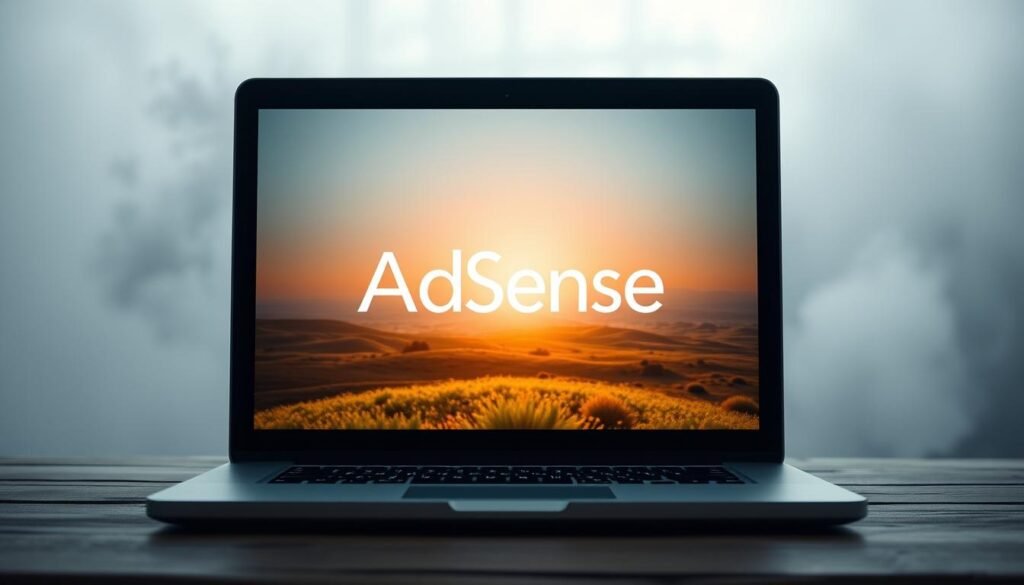Did you know that over 10 million websites use Google AdSense to make money? But, I found that relying only on AdSense can be a problem. It can also hurt how users feel about your site.
When my earnings dropped, I started looking for alternative methods to make money online. I found better ways to earn and improve my site’s performance. These new strategies helped me make more money and keep my site happy for users.
In this article, I’ll share my story and the AdSense alternatives I’ve used. These changes helped me keep my online business profitable.
Contents
- 1 My Journey with AdSense
- 2 The Decline of AdSense Effectiveness
- 3 AdSense Earnings Decline
- 4 Exploring Alternatives to AdSense
- 5 Why I Chose Affiliate Marketing
- 6 The Importance of SEO for New Revenue Streams
- 7 Creating Engaging Content
- 8 Leveraging Social Media for Growth
- 9 Monetizing My Email List
- 10 The Role of Digital Products
- 11 Diversifying Income Streams
- 12 Analyzing My Results
- 13 Lessons Learned From Leaving AdSense
- 14 Future Plans and Goals
- 15 FAQ
- 15.1 Why did you stop using AdSense?
- 15.2 What alternatives to AdSense did you explore?
- 15.3 Why did you choose affiliate marketing?
- 15.4 How important is SEO for your new revenue streams?
- 15.5 What role do digital products play in your revenue model?
- 15.6 Why is diversifying income streams important?
- 15.7 What metrics should I consider when analyzing my results?
- 15.8 What skills did you gain from leaving AdSense?
- 15.9 What are your future plans and goals?
- 15.10 Can I make money online without AdSense?
Key Takeaways
- Discover the limitations of relying solely on AdSense
- Explore alternative methods for generating income online
- Learn how to enhance user experience while increasing earnings
- Understand the benefits of diversifying your online revenue streams
- Find out how to maintain a profitable online presence without AdSense
My Journey with AdSense
When I first started with AdSense, I was excited about the idea of earning money passively. It seemed like a great way to make money without selling anything directly.
At first, I thought AdSense was amazing. It was easy to set up and offered many ad types. I thought it was cool that I could make money just by having ads on my site.
Initial Impressions of AdSense
I was really interested in the contextual ads AdSense provided. They matched my content well, which I thought would make my site better for users. Setting up ads was simple, and I could start right away.

Revenue Potencial vs. Reality
But as time went on, I saw a big difference between what AdSense promised and what I actually made. Even with a lot of visitors, my ads didn’t get clicked much. This meant my earnings were not as high as I had hoped.
I started looking into why this was happening. I found out about ad blockers, how people’s behavior online was changing, and how advertising was evolving. It became clear that AdSense alone wasn’t going to make me as much money as I thought.
The Decline of AdSense Effectiveness
I soon found out that AdSense wasn’t as profitable as it used to be. Its earnings started to drop over time. This decrease wasn’t sudden but a gradual change due to several factors.
One big reason was the new algorithms for showing ads on my blog. These algorithms aimed to make ads more relevant and user-friendly. But, they sometimes hurt my ad earnings.
Changing Algorithms and Their Impact
The algorithms that control ad visibility and click-through rates keep getting smarter. But, this improvement sometimes means fewer ads for me. This directly affected my AdSense income.
Key changes included:
- Tighter ad placement rules
- More focus on user experience, leading to fewer ads
- Better ad targeting, but sometimes fewer clicks
These updates, though good for users, made it hard to keep my earnings steady.
Ad Blockers and User Experience
Ad blockers also played a big role. As people learned more about online ads, ad blockers became more popular. This cut down my AdSense income even more.
The impact was twofold:
- Directly, fewer ads and clicks
- Indirectly, by making users less likely to visit ad-supported sites
To fight this, I had to change how I made money. I looked for ways that were less annoying and more in line with what users wanted.

Exploring new blog revenue models and website monetization tips became key. I started to find different ways to earn money, beyond just AdSense.
This shift not only helped me adjust to the changing ad world. It also brought new chances for growth and connecting with my audience.
AdSense Earnings Decline
As my AdSense income fell, I knew it was time to change how I made money. The drop wasn’t sudden but happened over months. I looked into why my earnings were going down.
Falling Click-Through Rates
One big reason was my click-through rates (CTR) were dropping. CTR shows how many people click on ads compared to how often they see them. A lower CTR means ads aren’t grabbing people’s attention like they used to.
Many things led to this drop, like more competition and changes in how people use the internet. I started working on making my content more engaging and relevant to my readers.
Conversion Rates That Frustrated Me
My earnings also fell because of low conversion rates. Conversion rates show how many people do what we want after clicking an ad. Even with lots of clicks, not enough were turning into money.
This made me look for alternative passive income streams. I started checking out AdSense alternatives that might give me better returns and more stable income.

To understand the decline and find new ways to make money, I looked at my AdSense earnings over time. The numbers showed a steady drop in income, leading me to dig deeper.
| Month | AdSense Earnings | Click-Through Rate |
|---|---|---|
| January | $1,000 | 2.5% |
| February | $900 | 2.2% |
| March | $800 | 2.0% |
The table shows how my AdSense earnings and click-through rates both went down. This confirmed my choice to look for new ways to make money and spread out my income sources.
Exploring Alternatives to AdSense
My journey away from AdSense showed me better ways to make money online. I learned that having different ways to earn was key to a stable income.
I started looking into affiliate marketing. This meant working with brands and getting paid for sales made through my links.
Affiliate Marketing Opportunities
Affiliate marketing was a great chance for me to make money from my audience. I picked products that fit my niche, making it easy to promote them.
The perks of affiliate marketing are:
- Earning commissions on sales
- Promoting products that resonate with my audience
- Diversifying my revenue streams beyond traditional advertising
To show how good affiliate marketing can be, let’s compare it:
| Monetization Strategy | Earning Potential | Audience Engagement |
|---|---|---|
| AdSense | Low to Moderate | Low |
| Affiliate Marketing | Moderate to High | High |
Direct Sponsorships and Brand Collaborations
I also looked into direct sponsorships and brand collaborations. This let me create sponsored content that my audience loved.
This way, I got a new income source and built strong bonds with brands that shared my values.

By trying these new ways to make money, I cut down on AdSense and made my online business more stable.
Why I Chose Affiliate Marketing
Affiliate marketing stood out to me because it fits my niche well and brings in good money. It’s a better way to make money than traditional ads.
Higher Commissions and Niches
I chose affiliate marketing for the higher commissions it offers. By promoting products that match my niche, I earn more for each sale.
Targeting specific niches makes my marketing more effective. This means I can sell more because the products fit what my audience wants.
Building Long-Term Relationships
Affiliate marketing helps me build long-term relationships with brands. By promoting their products, we both win.
These partnerships give me insights into what my audience likes. This helps me make better content and marketing plans.
| Benefits | Affiliate Marketing | Traditional AdSense |
|---|---|---|
| Commission Rates | Higher | Lower |
| Niche Targeting | Effective | Limited |
| Long-Term Relationships | Possible | Not Typical |
Using affiliate marketing has made my income more varied and my content more engaging for my audience.
The Importance of SEO for New Revenue Streams
SEO became a key part of my plan to make more money online. It showed me how to grow naturally. A well-optimized website is essential for drawing in and keeping the right audience.
I had to decide between organic traffic and paid advertising. Paid ads work fast, but organic traffic is better for keeping costs down over time.
Organic Traffic vs. Paid Advertising
Organic traffic is cheaper and often leads to more sales than paid ads. People trust organic results more because they seem more relevant and trustworthy.
- Organic traffic is cost-effective and sustainable.
- Paid advertising can offer immediate visibility but at a recurring cost.
- SEO enhances website credibility and trust among users.
Keyword Research and Content Strategy
A good keyword research and content strategy are key to SEO success. By finding the right keywords and making engaging content, I boosted my site’s search engine ranking.
- Do deep keyword research to find the right terms.
- Make a content strategy that meets user needs and uses target keywords.
- Keep updating content to stay fresh and relevant.
By focusing on SEO and a solid content strategy, I improved my online presence. This led to more organic traffic and more money coming in.
Creating Engaging Content
Knowing what my audience wants has been key to making content that grabs and keeps their interest. Moving away from AdSense, I learned that engaging content is essential for a successful blog. It’s the foundation of making money from a blog.
To make this happen, I had to explore different content types. I tried many formats to see what my readers liked best. It was a lot of trial and error, but it was worth it. It boosted my blog’s engagement.
Understanding My Audience's Needs
First, I had to figure out who my audience is and what they want. I analyzed data and feedback to make my content fit their tastes.
I used tools like website analytics and social media insights to understand my audience. This helped me make my content better. It increased engagement and loyalty from my readers.
Diversifying Content Types and Formats
Mixing up content keeps it interesting. I started adding videos, podcasts, and infographics to my blog posts.
This attracted more readers and kept the ones I had happy. Some liked videos, while others preferred podcasts. It was a win-win.
By using different blog revenue models, I reached more people. It made my blog more appealing. This approach helped me keep a loyal readership and boost my earnings.
In short, making engaging content is complex. It involves knowing your audience and trying different content types. By doing this, bloggers can improve their blog’s success and earnings.
Leveraging Social Media for Growth
As I explored online monetization, I saw how important social media is. At first, I doubted its effect on my website’s earnings. But, as I dug deeper, I saw its true value.
Platforms That Yielded Results for Me
I found that different social media sites worked better for me. For example, Facebook and Instagram helped me reach more people. On the other hand, Twitter was great for quick conversations.
- Facebook: Good for ads and building a community.
- Instagram: Perfect for sharing photos and working with influencers.
- Twitter: Great for fast updates and news.
Engaging with Followers Effectively
Building a loyal community on social media starts with engagement. I learned that replying to comments and creating fun content really helped. It made my followers more active.
| Engagement Strategy | Impact |
|---|---|
| Responding to Comments | Increased follower loyalty |
| Social Listening | Improved content relevance |
| Interactive Content | Boosted engagement rates |
By using these tactics and knowing each platform’s strengths, I grew my online presence. Social media became a key driver of my success.
Monetizing My Email List
Starting my email marketing journey opened up new ways to earn money. It’s been a learning experience, helping me connect with my audience. I now promote products or services that are relevant to them.
Building the Newsletter
My first step was creating a newsletter that my audience loved. I made sure the content was engaging and valuable. I listened to what my subscribers wanted, making the newsletter just for them.
Some key strategies I used included:
- Segmenting my email list to ensure targeted content
- Creating a welcome series for new subscribers
- Regularly sending out newsletters with a mix of promotional and informative content
Email Marketing Strategies That Work
I’ve found several email marketing strategies that work well. One of the best is promoting products or services that my audience wants. This way, I meet their needs and increase sales.
Using email automation has also been a game-changer. It lets me nurture leads and encourage sales without sending emails manually every time.
“The key to successful email marketing lies in understanding your audience and delivering content that resonates with them.”
| Email Marketing Strategy | Conversion Rate | Revenue Generated |
|---|---|---|
| Promotional Emails | 5% | $1,000 |
| Automated Email Sequences | 8% | $1,500 |
| Newsletters | 3% | $800 |
Looking at these results, I’ve improved my email marketing strategies. I focus on what brings in the most money. This data-driven approach has helped me earn more from email marketing.
The Role of Digital Products
Digital products are key to my financial success, a better choice than AdSense. By making and selling my own digital items, I’ve spread out my income. This gives me more control over how much I earn.
Creating and Selling My Own Products
Starting with digital products, I first figured out my niche and what my audience wanted. I made ebooks and online courses to solve their problems.
I used Gumroad and Teachable to sell my products. This made things easier for me. I could then focus on marketing and getting the word out.
Benefits of Digital Goods Over AdSense
Digital goods offer higher profits compared to AdSense. With AdSense, earnings depend on ad clicks and views. But digital products can grow with sales.
Also, digital products give me greater control over pricing, how they’re sold, and talking to customers. This is great for keeping up with market changes and what customers want.
| Feature | AdSense | Digital Products |
|---|---|---|
| Earnings Potential | Limited by ad clicks and views | Scalable with product sales |
| Control Over Revenue | Limited, dependent on ad network | High, can adjust pricing and sales strategy |
| Customer Interaction | Indirect, through ad metrics | Direct, through sales and feedback |
In conclusion, digital products have not only diversified my income. They’ve also given me a more stable and controllable way to earn money compared to AdSense.
Diversifying Income Streams
My journey to financial freedom started with looking for new ways to make money online. I found out that relying on just one source of income was too risky. It was like putting all your eggs in one basket.
To feel more secure, I started to diversify my income streams. I looked into different ways to make money, not just AdSense. This smart move made my finances more stable and opened up new chances for growth.
Exploring Other Advertising Networks
One of my first steps was to check out other ad networks. I found that Media.net and Amazon Associates had good rates and different ad types. These could match what my readers liked.
- Media.net had ads that fit my content perfectly.
- Amazon Associates let me earn by promoting products in my niche.
- Other networks like AdThrive and ShareASale gave me even more ways to make money.
The Power of Multiple Income Sources
Having many income sources changed the game for me. It made me less dependent on just one way to make money. It also let me try out different monetization strategies.
- Affiliate marketing became a big source of passive income.
- Sponsored content and product placements added more money.
- Creating and selling digital products also helped diversify my income.
In short, having different income streams is key to financial stability and freedom. By exploring other ad networks and using many income sources, I built a strong financial base.
Analyzing My Results
Understanding the success of my new monetization strategies was key. After leaving AdSense, I watched various metrics closely. This helped me see how well my new ways of making money were working.
Metrics to Consider
I looked at a few important metrics to analyze my results. These were website traffic, click-through rates (CTR), and conversion rates. These numbers showed me how my audience was interacting with my content and ads or affiliate links.
For example, a high CTR but low conversion rate might mean my content is engaging but the offers don’t match my audience’s needs. On the other hand, a low CTR but high conversion rate could show that the offers are great, but my content isn’t drawing enough attention.
Adapting My Strategy for Success
After looking at my analytics, I made some changes. I optimized my content to better match what my audience likes and needs. This led to more engagement. I also refined my targeting for affiliate marketing and sponsorships, making sure the products or services I promoted fit my audience’s preferences.
I also added more video content and interactive elements to my site. This made my site more engaging and improved user experience.
By always checking my results and tweaking my strategy, I built a more stable and profitable online presence. This ongoing process is key to staying successful in the digital world.
Lessons Learned From Leaving AdSense
Leaving AdSense was a big turning point for me. It taught me a lot about finding new ways to make money online. Looking back, I see how key it is to have different ways to earn money in the digital world.
What I Wish I Had Known Sooner
One big lesson I learned is the need to look into AdSense alternatives before giving up on it. I wish I knew about affiliate marketing and direct sponsorships sooner. They’ve turned out to be more profitable and stable over time.
- The value of building a loyal audience through quality content
- The power of affiliate marketing in specific niches
- The perks of direct sponsorships and brand partnerships
Knowing about these options earlier would have helped me switch over easier and grab opportunities faster.
Skills I Gained Along the Way
My journey away from AdSense has given me many useful skills. I’ve gotten better at SEO optimization, creating different types of content, and email marketing. I’ve also learned to use data to make better business choices.
- Improved SEO skills to boost organic traffic
- Ability to make engaging content in various formats
- Effective email marketing strategies to grow my audience
These skills have not only helped me earn money online without AdSense. They’ve also opened up new paths for growth and income.
In conclusion, leaving AdSense has been a game-changer for me. It taught me about the importance of diversification, skill-building, and exploring new online business models.
Future Plans and Goals
I’m excited to share my future plans and goals as I continue on my online business journey. I’ve moved beyond AdSense and found many effective ways to make money. These strategies have greatly increased my income.
Staying Ahead of the Curve
Learning and adapting are key in the fast-changing online world. I’m dedicated to keeping up with the latest trends and best practices. This includes affiliate marketing, SEO, and creating digital products.
New Opportunities on the Horizon
I’m looking forward to trying out new platforms and opportunities. This could be through new social media channels or innovative advertising networks. By exploring different ways to make money, I’m sure my business will stay strong and profitable.
With a solid base, I’m ready for more growth and success in online business. I’ll use the best ways to make money to reach my goals.
FAQ
Why did you stop using AdSense?
I stopped using AdSense because my earnings were going down. The algorithms changed, and ad blockers became more common. This made my money and user experience suffer.
What alternatives to AdSense did you explore?
I looked into affiliate marketing, direct sponsorships, and brand collaborations. These are now big parts of how I make money.
Why did you choose affiliate marketing?
I picked affiliate marketing for its better commissions. It lets me focus on specific areas and build lasting relationships with brands.
How important is SEO for your new revenue streams?
SEO is very important for my new ways to make money. It helps me get more visitors, improve my content, and be seen more online.
What role do digital products play in your revenue model?
Digital products are a big part of my income. They give me higher profits and more control over my earnings than AdSense did.
Why is diversifying income streams important?
Having different ways to make money is key for financial stability. It helps me not rely too much on one source and adapt to changes online.
What metrics should I consider when analyzing my results?
Important metrics include click-through rates, conversion rates, and earnings per click. They show how well my money-making plans are working.
What skills did you gain from leaving AdSense?
I learned a lot about affiliate marketing, creating content, and email marketing. These skills are very useful for my online business now.
What are your future plans and goals?
My plans include always learning and staying up-to-date. I want to try new platforms and keep my online business growing and profitable.
Can I make money online without AdSense?
Yes, you can earn money online without AdSense. Look into affiliate marketing, sponsored content, and digital products as alternatives.


